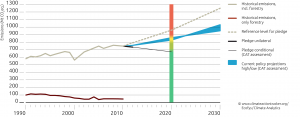In 2010, Mexico was the 11th largest emitter of greenhouse gases in the world, emitting 688.25 million metric tons of carbon dioxide equivalent according to the World Resources Institute’s Climate Analysis Indicator’s Tool (CAIT). Overall, this is 1.55% of global carbon emissions.
The following graph shows the projected emissions under BAU, pledges, as well as current policy projections high and low according to the Climate Action Tracker (CAT):

Also in 2010, Mexico hosted the 16th U.N. Climate Change Conference (COP 16) which aimed to build a framework for global emissions cuts. Participating governments agreed to keep the average global temperature below an increase of two degrees Celsius, although there were no concrete plans made. However, in 2012, Mexican President Felipe Calderon signed into law a General Law on Climate Change. He announced on his Twitter that Mexico became the first developing country with a comprehensive law against climate change.
The 2012 law set targets for emissions reductions and set a plan for an expansion of renewable energy. The Mexican law was the second of its kind (Great Britain was first), and is the first initiative from a developing country. It details the following targets:
- To cut greenhouse gas emissions by 30% by 2020
- To cut greenhouse gas emissions by 50% by 2050
- For 35% of Mexico’s energy to come from renewables by 2024
This plan requires very extensive reductions; however, the plan from 2009-2012 has now concluded and there has not been an equivalently mapped out plan for the time periods 2012-2020 and 2020-2050. The current policies are continuations of former ones without any new ones; if no new policies are put into place, the goal of a 50% reduction by 2050 will not be obtainable.
As of December 2013, new legislation has passed breaking up the state owned oil, gas and electricity monopoly. While not beneficial to the market, the government dominated industries had he ability to push through climate change reform if the president so desired. Now, without the same control, a stronger effort needs to be made to show potential benefits to political leaders as well as local citizens. Policies that help the environment do not necessarily need to be uneconomical. Mexico has a variety of options in solar and wind to meet reductions pledges and should look into expanding some of these options. See my upcoming blog post: Mexico’s Renewables: Opportunities in Wind and Solar.
Mexico is currently the 11th largest emitter of greenhouse gasses in the world, but as a developing country, this number will increase over the coming decades. Mexico cannot afford to rely on voluntary policies and a “developing country” status forever.
